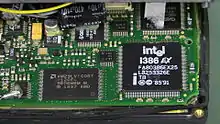Intel 80386EX
The Intel 80386EX (386EX) is a variant of the Intel 386 microprocessor designed for embedded systems. Introduced in August 1994 and was successful in the market being used aboard several orbiting satellites and microsatellites.

An Intel i386 EX embedded processor inside a Garmin GPS III+
Intel did not manufacture another integrated x86 processor until 2007, when it confirmed the Enhanced Pentium M-based Tolapai (EP80579).[1]
Characteristics
- Introduced August 1994
- Variant of 80386SX intended for embedded systems
- 26-bit memory addressing for up to 64 MiB of DRAM
- 16-bit data bus, limiting performance but reducing system cost
- Static core, i.e. may run as slowly (and thus, power efficiently) as desired, down to full halt
- On-chip peripherals:
- clock and power management
- timers/counters
- watchdog timer
- serial I/O units (synchronous and asynchronous) and parallel I/O
- DMA
- RAM refresh
- JTAG test logic
- Significantly more successful than the 80376
- Used aboard several orbiting satellites and microsatellites
- Used in NASA's FlightLinux project
- Used in USRobotics Courier I modem V.everything (Internal ISA and External RS232 ISDN Terminal Adapters with 56KBPS analog remote access server).
- Used in Ericsson R290 satellite phone
- Used in many older Garmin GPS units, such as the GPS 48, II, III, and 12.[2][3]
- Used in Akai S5000 & S6000 digital samplers.
References
This article is issued from Wikipedia. The text is licensed under Creative Commons - Attribution - Sharealike. Additional terms may apply for the media files.
